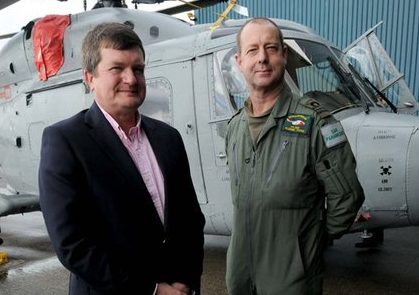Friday, April 27, 2012
A helicopter heroine whose windscreen was holed by gunfire in the Falklands War and had her finest hour sinking five Iraqi gunboats in the First Gulf War has become the Fleet Air Arm Museum Yeovilton’s latest star. And the pilot and observer who scored that remarkable quintet were there to see Royal Navy Lynx Mk 3 XZ720 pass into history yesterday.
 David Livingstone, left, who piloted the Lynx in the First Gulf War and observer, Florry Ford
David Livingstone, left, who piloted the Lynx in the First Gulf War and observer, Florry Ford
The aircraft’s remarkable record is emblazoned on her paintwork in the five black missiles on either side of her fuselage.David Livingstone, who was the aircraft’s pilot in the First Gulf War won the Distinguished Service Cross for his actions.He and his observer, Florry Ford, then a young Sub Lieutenant, told how they earned their remarkable tally, with Sea Skua missile, while flying from the destroyer HMS Gloucester, including three sinkings in one day and a night mission under enemy attack.
Mr Livingstone, 51, of Taunton, who was a Lieutenant Commander at the time recalled: “On January 30 We were on a patrol and got a contact which was a patrol boat which the Iraqis had taken from the Kuwaiti Navy,“Under the rules of engagement we could not fire without permission to engage. Once we had that we fired and while we engaged another contact appeared from nowhere so as soon as we sank the first one we fired on the second. It was a Russian-built mine-layer.”Their third strike came that afternoon.
The next day a menacing Iraqi patrol boat appeared as the pair were supporting Americans carrying out search and rescue operations. They hit their target, while the cluster bombs of a an American A6 jet missed.Ten days later they were tasked to hunt a mine at night, under the dubious light of parachute flares when they spotted a Russian-built fleet supply vessel on its way to resupply Iraqi forces. They fired two missiles but also came under attack from two surface-to-air missiles.
Mr Livingstone took evading action, and Mr Ford warned the missiles were still on track.To avoid disaster Mr Livingstone had to fly the superbly agile helicopter within 20 feet of the sea. The enemy missiles passed just 180 feet away.The helicopter, built at Westland at nearby Yeovil joined Yeovilton-based 815 Naval Air Squadron in 1980 and saw active service with HMS Alacrity in the Falklands War, where she was on the receiving end of machine gun fire from an Argentinian gun boat.The pilot Lieutenant Rob Sleeman fortunately avoided a bullet, which came through his window screen only by turning his head.
The aircraft has been on active service until her retirement.
A special team of engineers restored her to her 1991 colours and specification. Serviceable parts were also removed for the use of the serving Lynx fleet, and replaced by others.
Yeovilton’s commanding officer, Commodore Paul Chivers, himself a Lynx Observer, accepted the helicopter on behalf of the museum of which he is a trustee.
Museum director Graham Mottram said: “We are delighted to have her, she is proof that history is a continuing process.”